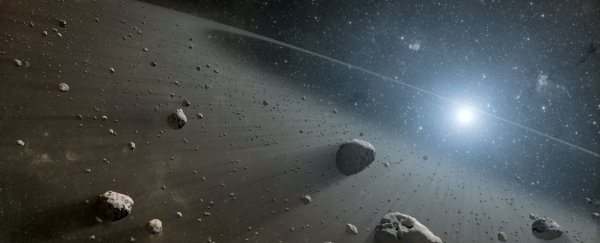The rain of meteorites from space onto our planet over the last 500 million years may not have fallen in quite the way we thought.
After analyzing 8,484 kilograms (18,704 pounds) of sedimentary rock from ancient seabeds, scientists have found that major collisions in the asteroid belt have not made any significant contribution to the number of meteorite impacts on Earth, as had been theorized.
It's a discovery scientists say could help protect Earth from asteroid impacts in the future.
"The research community previously believed that meteorite flux to Earth was connected to dramatic events in the asteroid belt," said geologist Birger Schmitz of Lund University in Sweden. "The new study, however, shows that the flux has instead been very stable."
Tracking Earth's meteorite history isn't exactly easy. Impact events involving large bodies that leave a significant crater are rare; many space rocks break apart on atmospheric entry, leaving only debris to fall to Earth.
This debris is what Schmitz and his colleagues have been chasing: tiny fragments of micrometeorite, preserved in the sedimentary layers of Earth's crust.
From ancient seabeds in China, Russia, and Sweden, they extracted thousands of kilograms of limestone, representing 15 different time periods in the Phanerozoic Eon.
These limestone chunks were then dissolved in acid, a technique that allows the extraction of chrome spinels - tiny pieces of chromium oxide, a degradation-resistant mineral found in meteorites.
"In total, we have extracted chromium oxide from almost 10,000 different meteorites," Schmitz said. "Chemical analyses then enabled us to determine which types of meteorites the grains represent."
Fascinatingly, their results show a stable flux, mostly consisting of chondritic (stony non-metallic) meteorites, similar to the present-day flux. The glaring exception is an increase in this type of meteorite 466 million years ago, associated with the break-up of an L-chondrite parent body, a type of meteorite conspicuously low in iron.
During this time, meteorite flux increased by a factor of up to 300, and 99 percent of the grains were from this one parent body, tailing off after about 40 million years, but never quite ceasing. Even today, around one-third of all meteorites falling to Earth are from this parent body.
This suggests that the asteroids that do leave the asteroid belt between Mars and Jupiter seem to come from a very small region.
"We were very surprised to learn that only one of the 70 largest asteroid collisions that took place over the past 500 million years resulted in an increased flux of meteorites to Earth," Schmitz said. "For some reason, most of the rocks stay in the asteroid belt."
We're not sure what this reason is, yet, but it could help us understand what kinds of objects are likely to collide with Earth, and where they come from. That's if the team's findings are validated, of course; as they mention in their paper, the sampling might not be comprehensive.
There's a 190-million-year stretch of time from the Carboniferous to the early Jurassic with no chrome-spinel data, and we know there was an asteroid break-up that affected Earth during that time. An asteroid family that emerged during the Cretaceous - the team's most densely-sampled period - also shows no significant increase in flux for this type of meteorite.
Future research could help uncover the reasons behind these discrepancies. For now, the research represents a new way of understanding Earth's meteorite impact history, and what we might expect going forward.
"Future impact from even a small asteroid for example in the sea close to a populated area could lead to disastrous outcomes," Schmitz said. "This study provides important understanding that we can use to prevent this from happening; for example, by attempting to influence the trajectory of rapidly approaching celestial bodies."
The research has been published in PNAS.
